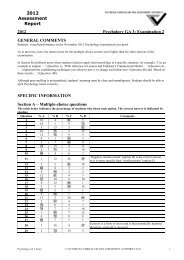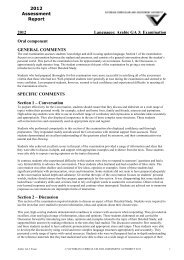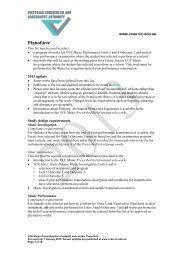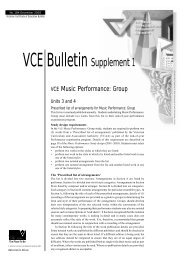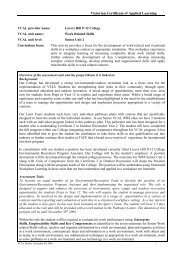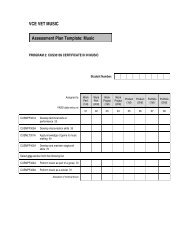television, digital media and children's learning - Victorian ...
television, digital media and children's learning - Victorian ...
television, digital media and children's learning - Victorian ...
You also want an ePaper? Increase the reach of your titles
YUMPU automatically turns print PDFs into web optimized ePapers that Google loves.
PART A –Today’s technology<br />
1. CURRENT SITUATION<br />
Television, film <strong>and</strong> computer games are already playing a role in educating young children<br />
but there is significant potential to capitalise on their ability to enhance development <strong>and</strong><br />
<strong>learning</strong>.<br />
Media technology is pervasive <strong>and</strong> covers:<br />
• radio <strong>and</strong> <strong>television</strong> broadcasting on in-house sets, iPods <strong>and</strong> portable players or on<br />
mobile phones<br />
• films <strong>and</strong> TV programs broadcast or on DVDs<br />
• computer games on PCs, laptops or h<strong>and</strong>-held modules <strong>and</strong> interactive games on the<br />
internet<br />
• communicative <strong>media</strong> such as chat rooms, mobiles <strong>and</strong> email.<br />
This paper focuses primarily on children under the age of eight who are less involved with the<br />
communicative <strong>media</strong>.<br />
Research suggests most children acquire many of their <strong>media</strong> literacy functional skills early<br />
<strong>and</strong> without much formal instruction.<br />
Children under age 6 already have good <strong>media</strong> skills – by themselves:<br />
• 74% can turn on the TV<br />
• 58% can use the remote<br />
• 46% can put on a video or DVD.<br />
A recent Australian Communications <strong>and</strong> Media Authority survey of <strong>media</strong> use (ACMA, 2007)<br />
found that children aged 0-4 spent:<br />
• 154 minutes per day viewing free-to-air <strong>television</strong> (127 minutes on commercial channels)<br />
• 194 minutes per day watching subscription TV.<br />
That makes a total viewing time average of 5 hours 48 minutes per day for the youngest<br />
children who are the heaviest viewers of <strong>television</strong> in the family. Programs made for these<br />
children are often inadequate <strong>and</strong> the children are regularly viewing adult programs for much<br />
of the day.<br />
Comparable figures for 5-12 year olds were:<br />
• 130 minutes per day viewing free-to-air<br />
• 160 minutes for subscription TV.<br />
This represents a total viewing time average of 4 hours 50 minutes per day. This average is<br />
arguably too much for young children who need a variety of physical <strong>and</strong> social experiences<br />
for healthy development. Averages also hide the extensive viewing by children at the upper<br />
limit of the normal distribution curve that takes up a large proportion of a child’s day.<br />
The Australian Institute of Family Studies’ Longitudinal Study of Australian Children (LSAC)<br />
provides an indication of variations in <strong>media</strong> use by different social groups in Australia. For<br />
example:<br />
3




